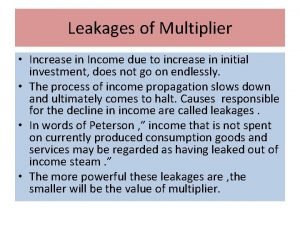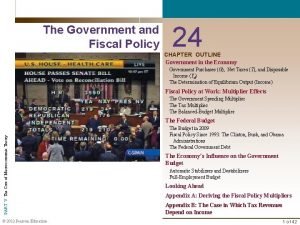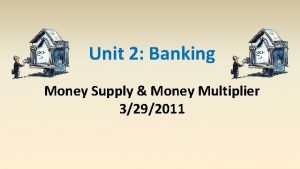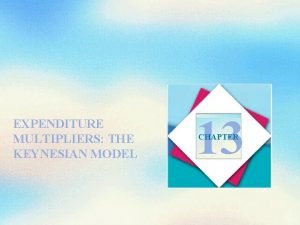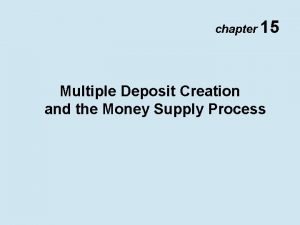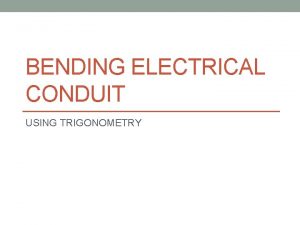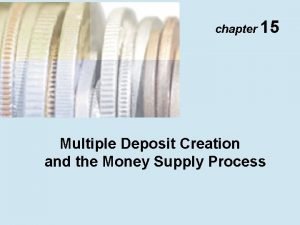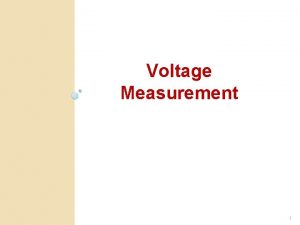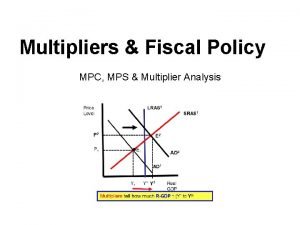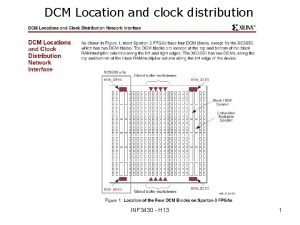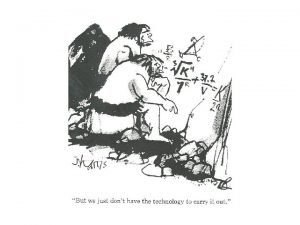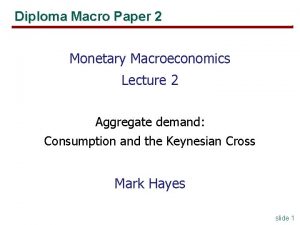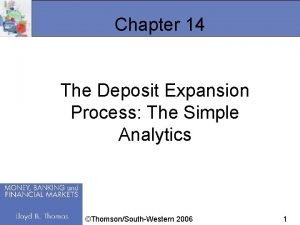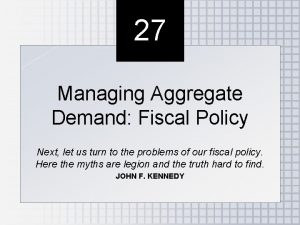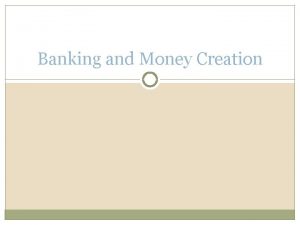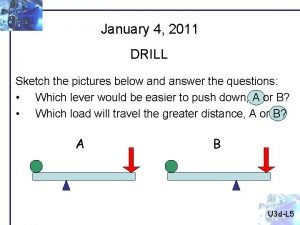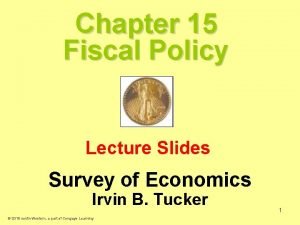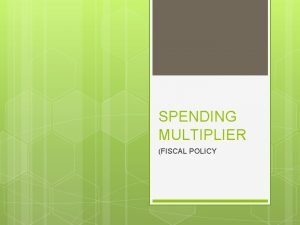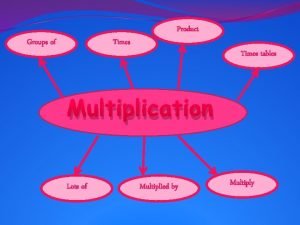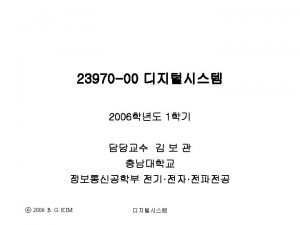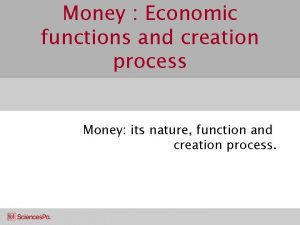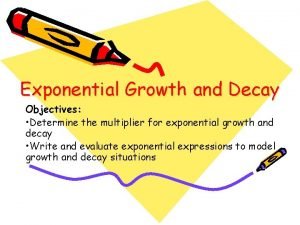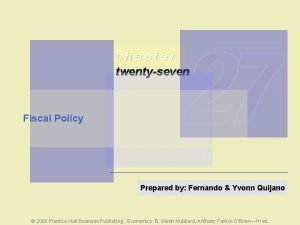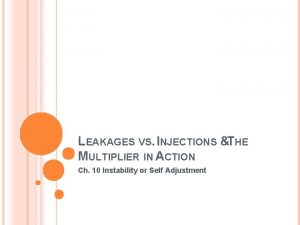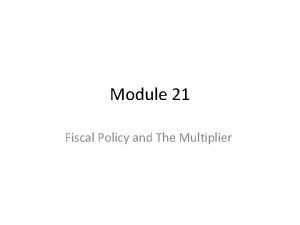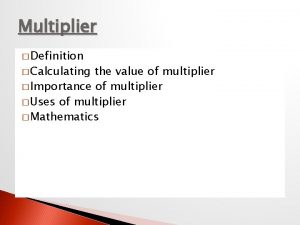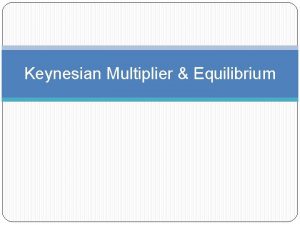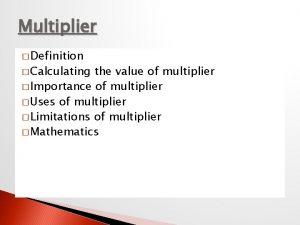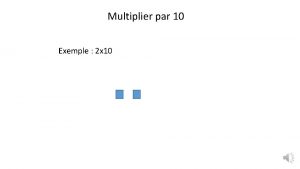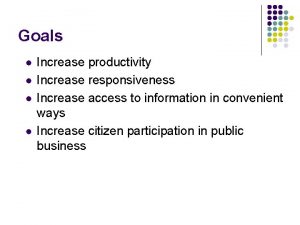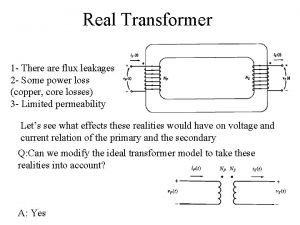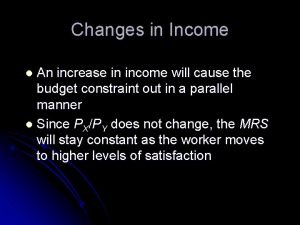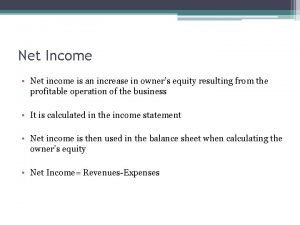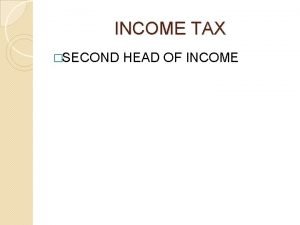Leakages of Multiplier Increase in Income due to



























































- Slides: 59

Leakages of Multiplier • Increase in Income due to increase in initial investment, does not go on endlessly. • The process of income propagation slows down and ultimately comes to halt. Causes responsible for the decline in income are called leakages. • In words of Peterson , ” income that is not spent on currently produced consumption goods and services may be regarded as having leaked out of income steam. ” • The more powerful these leakages are , the smaller will be the value of multiplier.

Some important leakages • Idle saving : idle saving leads to equivalent fall in marginal propensity to consume. it results into fall in the value of multiplier. As a matter of fact , higher the MPS greater is the leakage from income propagation and smaller is the value of multiplier. • Purchase of govt. : securities and shares : when some part of increased income is used to purchase old shares and govt. securities means this part of income is not spent on consumer goods. Consequently , the flow of income stream falls.

• Paying of old debts : That part of increased income which is utilised in paying of old debts is obviously not spent on cosumption. This leakage also constricts the process of income generation. • Import: liquidity drains out of the system equivalent to the value of imports through which propensity to consume falls limiting the multiplier effect of increased investment. • Excess stock of consumption goods: increase in income leads to increase in consumption. if the increased demand for consumer goods is met out of the existing stocks , means new consumer goods are not produced that results into hampering the growth of multiplier.

• High liquidity Preference: it means if people want to hold more money in cash for transaction, precautionary and speculative motives, it would imply less expenditure also serves as a leakage of multiplier. • Price Inflation: under inflationary situation people have to spend more money to buy same amount of goods and services as before. The effect is that there will be not much increase in level of consumption and ultimately multiplier effect will remain limited. • Taxation system : if taxes on goods and progressive taxes on income are increased , there will be no appreciable increase in consumption despite increase in income. As a result process of income propagation slows down.

• Undistributed profits of companies: Many companies do not distribute all the profits among the shareholders; as they keep a part of it as a reserve fund. The undistributed profits also serves as a leakage of the multiplier because this amount is not made available to the shareholders who could use it as a consumption expenditure.

Importance of Multiplier • Income Propagation: concept of multiplier tells us that income propagation is a natural process. It tells that increase in employment, income and output is due to increase in investment. *Income is generated in an economy in much the same way as a stone thrown in a lake causes ripples. * • Importance of Investment: it is the initial increase in the investment that results in multiple increase in income. As a matter of fact, investment is that dynamic element on which changes in employment depend.

• Trade Cycles: trade cycles are those cycles which tell business fluctuations take place over a period of long run. Sometimes there is a boom and at another time there is depression in business. So multiplier helps in understanding trade cycles. • Full Employment: Multiplier’s concept is of great importance while formulating policy regarding full employment. it shows that to attain full employment situation a thrust of net investment should be made in the economy. • Deficit Financing: deficit financing helps in removing bad effects of depression. it is so because as a result of deficit financing investment increases and increase in investment causes multiple increase in income in terms of multiplier effect.

• Equilibrium between Saving and Investment: According to keynes theory of Employment , Equilibrium is established when Saving and Investment are equal. Equilibrium between Saving and Investment can be achieved through change in the level of income. If saving is low in an economy, it can be known from the concept of marginal propensity to save how much increase in income is needed to get the required increase in saving. And to increase the level of income how much investment is needed, can be determined from the co-efficient of multiplier. • Public Investment: concept of multiplier testifies that if during depression, a little increase in public investment is made, it will lead to multiple increase in income such an increase in income will help in controlling depression and unemployment.

Multiplier and Public Investment • Concept of multiplier propounded by John Meynard Keynes lays emphasis on the significance and utility of public investment. • Public investment refers to govt. expenditure on public works and public welfare activities. Purpose of this investment is not to earn profit , as is the case with private investment. It is called autonomous investment, because it is independent of profit motive. • Its objective is to increase employment and stimulate business during a cute depression

Relationship between Multiplier and Public investment • There is a close relationship between multiplier and public investment. Concept of multiplier proves that if during depression public investment is increased a little, it will lead to multiple increase in income. • With a view to realizing full-multiplier effect of investment , the govt. should take care of the following factors :

• Public investment should be made in those areas where MPC i. e (marginal propensity to consume) is maximum. MPC is more in underdeveloped and backward regions. • Public investment should be undertaken at a time when multiplier effect is maximum. It is maximum during boom and depression periods. • It is essential for the working of multiplier that on account of increase in Public investment, there should be increase in the total investment in country. • Income that increases on account of Public investment should not be concentrated in hands of the rich class as its marginal propensity to consume is low.

• As soon as economy attains full employment situation, the public investment should be slashed considerably. If it is not done, the multiplier effect of public investment may give rise to inflation in the economy. • public investment should be so coordinated as to get maximum multiplier effect. At the same time, care should be taken to ensure that as soon as signs of boom situation appear, the govt. should slow down public investment or vice –versa.

• Tautological : it is a Tautological concept wherein the same thing has been said repeatedly in different words. it does not express anything new. • Relation between Income and Consumption: the assumption of multiplier that MPC is less than unity and remains constant is wrong ; because, in fact, Relationship between income and consumption is not so simple as is assumed by keynes. • Effect of Acceleration is Ignored: it does not take into consideration, change in investment as a result of change in consumption. In fact, multiplier is influenced not only by investment but also by consumption expenditure. if consumption expenditure is increased, the multiplier will continue to work, although no investment is undertaken.

• Unnecessary importance to Deficit Financing : concept of multiplier has given Unnecessary importance to Deficit Financing in preference to many important and appropriate methods of monetary policy. • Practical Defects : the Practical defects of concept of multiplier lies in the fact that it has made investment a casual factor whereas, in reality, investment is the effect of saving to a large extent. • Complete Elasticity in the Supply of Funds and Supply of Consumer’s Goods.

Types of Multiplier Employment Multiplier • The employment multiplier is the ratio of increase in total employment to the increase in primary or original employment. Foreign Trade Multiplier • The ratio of change in total income to change in export income is called foreign trade multiplier.

Employment Multiplier • This concept is related to increase in employment. According t∆o R. F khan increase in investment will cause in increase in employment not only in those very industries where in such investment has been made but in other industries also. • Employment increases in two ways. 1) Primary Employment 2) Secondary Employment • Employment Multiplier can be expressed by an equation as follows. K 1=N 2/N 1 (Here k 1=employment multiplier; N 2= Total employment; N 1= Primary employment. )

Foreign Trade Multiplier • When foreigners import goods from our country , domestic export industries earn revenue. Income of those people who work in export industries will increase. They will increase their consumption expenditure. • The effect of it will be that, income of those who produce consumer goods will rise. • In this way increase in export income, aggregate income increases many times more. • It can be expressed by an equation as follows. Kf= ∆Y/ ∆E.

Working Of Multiplier in under developed countries Multiplier does not work in the same manner in under developed countries as in developed countries. According to keynes, in developed economy an increase investment leads to multiple increase in income because of the multiplier effect. The increase in income depends on MPC. • No doubt, MPC is high in under developed countries, the value of multiplier is low.

Reason for why the value of multiplier is low, despite of high degree of MPC

• Working of multiplier holds good when a part of an increased income, as a result of increase in investment, is spent in the second round. On account of this expenditure in the second round there will be a corresponding increase in income. In this way income will go on rising. But , 1. In underdeveloped countries , when income increases initially as a result of increase in investment then this increased income when spent in the market is not matched by the corresponding flow of goods and services. 2. That is, in these economies increase in consumption expenditure is not accompanied with increase in production. Ultimately increase in consumption expenditure is followed by rise in prices

1. Firstly, they will make more use of their produce for self consumption it will cause corresponding fall in the marketable surplus. 2. Secondly, they will increase their demand for industrial goods, but the production capacity of the firms producing industrial goods is also limited. Hence despite increase in demand for industrial goods their real output does not increase ; rather prices begin to rise.

• Another reason being that: when income of the people , in these economies increases it pushes up the demand for food because of extreme poverty. • Increased demand for food and other agricultural products leads to increase in the income if the farmers. The increased income the farmers will not cause any increase in investment because; 1. Supply of agricultural products is inelastic , and 2. In under developed countries there is a shortage of resources for the development of agriculture. • So, farmers will use their increased income in two ways :

• According to Dr Rao, keynes concept of multiplier is based on certain assumptions, such as : 1. Open employment 2. Industrialized economy 3. Excess capacity in consumption goods industries 4. Comparatively elastic supply of raw material and working capital. • All these assumptions are lacking in under developed countries. In these countries there is disguised unemployment instead of involuntary unemployment. • Hence for want of assumptions of multiplier in under developed countries this concept is not fully applicable to them. In these countries since supply does not increase immediately in response to increase in investment, prices and not real income begin to rise.

Dynamic Concept Of Multiplier • Keynes concept of multiplier is criticized as a static concept. It is a static concept because it simply tell how many times more increase in income will be there as a result of given increase in investment. However, this concept does not reveal how and with what time-lag this increase in income will take place. It simply tell about the final conclusion. The modern economist study multiplier in dynamic form it show the working of multiplier.

Assumptions The modern theory of the multiplier is based on the following assumptions: • The consumption of the current period (c 1)depends on the income of the previous period (yt-1). • There is time lag between investment and income. On other words investment in period t will increase income in period t+1. it means Yt+1=(f. It).

Explanation • The modern theory of dynamic multiplier can be explained with the help of table and figure a and b. it should be remembered that there is time lag between change in investment and income. Whenever initial investment is increased it takes lot of time to increase. This increase in income is not immediate take place. In this time lag, many other changes may take place. • The dynamic concept of multiplier tell us how, from the time of initial change in investment, the process of multiplier moves on. The concept of multiplier proves valid in the sense that increase in aggregate demand=aggregate increase in investment*marginal propensity to consume

• Table shows that as a result of initial increase in investment by Rs 100 crore, there is change in income by Rs 100 crore. Where MPC is. 5. hence on account of increase income by Rs 100 crore. Consumption will increased by 50 crore and 50 will be saved. • Expenditure of one man is an income of another in an economy. Hence due to expenditure of Rs 50 crore on consumption. Their will be an increased of Rs 50 crore in income on second time period. As a result of it, there will be increased in consumption by 25 crore and Rs 25 crore will be saved. • On account of increase in consumption expenditure by Rs 25 crore, there will be increase in income by Rs 25 crore in next time period. • Thus, in different time period as shown in the table income will go on increasing as a result of increase in consumption expenditure. Ultimately income will increase to Rs 200 crore multiplier(K) =

Diagrammatic Presentation • The process of multiplier is expressed diagrammatically in fig b. this diagram is drawn on the assumption that MPC=. 5 and that consumption ‘t’ time depend upon income of ‘t-1’ time. it means that the consumer does not spend his income immediately on it’s receipt but he spents it after a time period. there is time lag between income and consumption expenditure.

• In the fig, income is shown on ox-axis and expenditure on oy-axis. AS is aggregate supply curve drawn on 45*. AD is aggregate demand curve supposing , the initial equilibrium at an income level is Rs 100 crore. In this situation the entire income is consumed. Point A is an equilibrium point. Because at this point, AD=AS. Equilibrium point A is the initial point of multiplier process. Supposing an investment of Rs 100 crore is initiated in the economy. As a result of it aggregate demand curve will shift to AD 1. (c+i+ i) • As a result of increase in investment by Rs 100 crore there will be increase in income by Rs 100 crore in first round. • In the second round consumer will spend Rs 50 crore on consumption resulting in an increase in income by Rs 50 crore. • In third round the consumer will spend Rs 25 crore on consumption. As result, income will increase by 25 crore. • This process will continue till additional consumption expenditure becomes 0. this situation will arise at point E when the level of income become Rs 300 crore. It thus proves that an investment of Rs 100 crore ultimately leads to an increasing income by Rs 200 crore. • In other word, if MPC is 2 then an increase in investment by Rs 100 crore will ultimately leads to increase in income by Rs 200 crore.

Dynamic multiplier and change in investment Process of dynamic multiplier depends on change in investment. There may be two types of change in investment; 1. Single injection of investment; if investment is increased only once, it will result into change in income only once, thereafter income will revert back to its old level. Supposing MPC=0. 5 OR Multiplier is 2 An increase in investment by Rs. 10 crore will cause an increase in income by Rs. 10 crore in that period. Thereafter, as is shown in fig.

• In the first time period, income will increase by Rs. 5 crore. In the second time period, income will increase by Rs. 2. 5 crore. • In this way, after a few time period find effect of increase in investment will fade away and increase in income will fall to zero. Economy will return to initial level of expenditure.

2. Continuous injection of investment; effect of multiplier will be permanent if there is continous injection of investment in the economy. It will enable the income to move from its initial level to a new level. Change due to continous injection of investment.

The diagram is based on two assumption ; a)An investment of Rs. 10 crore is made in each time period. b) Marginal propensity to consume is 0. 5. To begin with, an investment of Rs. 10 crore will lead to an increase in income by Rs. 10 crore. Out of this increased income Rs. 5 crore will be spent on consumption, because MPC 0. 5. in this way, during the first time period, the total increase in income due to an investment of Rs. 10 crore and consumption-expenditure of Rs. 5 crore will be 15 crore. • In 2 nd time period, new investment will be Rs. 10 crore, consumptionexpenditure on account of increase in income in the first time period will be Rs. 5 crore and consumption-expenditure on account of increase in income, in the initial time period will be Rs. 2. 5 crore. Income in the different time period will go on increasing till it reaches to Rs. 20 crore. Which shows MPC=0. 5 and hence multiplier is 2.

Characteristics of Multiplier • Aggregate Demand ; That is, the investment and consumption, cause the multiplier effect. Economists generally associate multiplier with change in investment. However, change in consumption or government expenditure or exports can have the same effect. • It works in both directions, i. e. , forward and backward. • There is an inverse relationship between marginal propensity to save and the size of the multiplier. • Size of the multiplier depends upon the sixe of marginal propensity to consume. Higher the marginal propensity to consume, greater will be the sixe of multiplier. • Sixe of multiplier is reduced proportionate to the leakages of the current income flow. • Multiplier effect can operate continously only if there are continous and autonomous changes in expenditure in the economy.

Limitations of multiplier • • • Availability of consumer goods Multiplier period Less than full employment level Steady flow of investment Net incrase in expenditure Net increase in investment Autonomous investment Closed Economy Constant marginal propensity to consume

• • • Industrialized economy Surplus capacity in consumer goods industries Availability of other resources of production No change in the distribution of income No change in prices Acceleration effect ignored

Leakages of Multiplier • Increase in Income due to increase in initial investment, does not go on endlessly. • The process of income propagation slows down and ultimately comes to halt. Causes responsible for the decline in income are called leakages. • In words of Peterson , ” income that is not spent on currently produced consumption goods and services may be regarded as having leaked out of income steam. ” • The more powerful these leakages are , the smaller will be the value of multiplier.

Some important leakages • Idle saving : idle saving leads to equivalent fall in marginal propensity to consume. it results into fall in the value of multiplier. As a matter of fact , higher the MPS greater is the leakage from income propagation and smaller is the value of multiplier. • Purchase of govt. : securities and shares : when some part of increased income is used to purchase old shares and govt. securities means this part of income is not spent on consumer goods. Consequently , the flow of income stream falls.

• Paying of old debts : That part of increased income which is utilised in paying of old debts is obviously not spent on cosumption. This leakage also constricts the process of income generation. • Import: liquidity drains out of the system equivalent to the value of imports through which propensity to consume falls limiting the multiplier effect of increased investment. • Excess stock of consumption goods: increase in income leads to increase in consumption. if the increased demand for consumer goods is met out of the existing stocks , means new consumer goods are not produced that results into hampering the growth of multiplier.

• High liquidity Preference: it means if people want to hold more money in cash for transaction, precautionary and speculative motives, it would imply less expenditure also serves as a leakage of multiplier. • Price Inflation: under inflationary situation people have to spend more money to buy same amount of goods and services as before. The effect is that there will be not much increase in level of consumption and ultimately multiplier effect will remain limited. • Taxation system : if taxes on goods and progressive taxes on income are increased , there will be no appreciable increase in consumption despite increase in income. As a result process of income propagation slows down.

• Undistributed profits of companies : Many companies do not distribute all the profits among the shareholders; as they keep a part of it as a reserve fund. The undistributed profits also serves as a leakage of the multiplier because this amount is not made available to the shareholders who could use it as a consumption expenditure.

Importance of Multiplier • Income Propagation: concept of multiplier tells us that income propagation is a natural process. It tells that increase in employment, income and output is due to increase in investment. *Income is generated in an economy in much the same way as a stone thrown in a lake causes ripples. * • Importance of Investment: it is the initial increase in the investment that results in multiple increase in income. As a matter of fact, investment is that dynamic element on which changes in employment depend.

• Trade Cycles: trade cycles are those cycles which tell business fluctuations take place over a period of long run. Sometimes there is a boom and at another time there is depression in business. So multiplier helps in understanding trade cycles. • Full Employment: Multiplier’s concept is of great importance while formulating policy regarding full employment. it shows that to attain full employment situation a thrust of net investment should be made in the economy. • Deficit Financing: deficit financing helps in removing bad effects of depression. it is so because as a result of deficit financing investment increases and increase in investment causes multiple increase in income in terms of multiplier effect.

• Equilibrium between Saving and Investment: According to keynes theory of Employment , Equilibrium is established when Saving and Investment are equal. Equilibrium between Saving and Investment can be achieved through change in the level of income. If saving is low in an economy, it can be known from the concept of marginal propensity to save how much increase in income is needed to get the required increase in saving. And to increase the level of income how much investment is needed, can be determined from the co-efficient of multiplier. • Public Investment: concept of multiplier testifies that if during depression, a little increase in public investment is made, it will lead to multiple increase in income such an increase in income will help in controlling depression and unemployment.

Multiplier and Public Investment • Concept of multiplier propounded by John Meynard Keynes lays emphasis on the significance and utility of public investment. • Public investment refers to govt. expenditure on public works and public welfare activities. Purpose of this investment is not to earn profit , as is the case with private investment. It is called autonomous investment, because it is independent of profit motive. • Its objective is to increase employment and stimulate business during a cute depression

Relationship between Multiplier and Public investment • There is a close relationship between multiplier and public investment. Concept of multiplier proves that if during depression public investment is increased a little, it will lead to multiple increase in income. • With a view to realizing full-multiplier effect of investment , the govt. should take care of the following factors :

• Public investment should be made in those areas where MPC i. e (marginal propensity to consume) is maximum. MPC is more in underdeveloped and backward regions. • Public investment should be undertaken at a time when multiplier effect is maximum. It is maximum during boom and depression periods. • It is essential for the working of multiplier that on account of increase in Public investment, there should be increase in the total investment in country. • Income that increases on account of Public investment should not be concentrated in hands of the rich class as its marginal propensity to consume is low.

• As soon as economy attains full employment situation, the public investment should be slashed considerably. If it is not done, the multiplier effect of public investment may give rise to inflation in the economy. • public investment should be so coordinated as to get maximum multiplier effect. At the same time, care should be taken to ensure that as soon as signs of boom situation appear, the govt. should slow down public investment or vice –versa.

• Tautological : it is a Tautological concept wherein the same thing has been said repeatedly in different words. it does not express anything new. • Relation between Income and Consumption: the assumption of multiplier that MPC is less than unity and remains constant is wrong ; because, in fact, Relationship between income and consumption is not so simple as is assumed by keynes. • Effect of Acceleration is Ignored: it does not take into consideration, change in investment as a result of change in consumption. In fact, multiplier is influenced not only by investment but also by consumption expenditure. if consumption expenditure is increased, the multiplier will continue to work, although no investment is undertaken.

• Unnecessary importance to Deficit Financing : concept of multiplier has given Unnecessary importance to Deficit Financing in preference to many important and appropriate methods of monetary policy. • Practical Defects : the Practical defects of concept of multiplier lies in the fact that it has made investment a casual factor whereas, in reality, investment is the effect of saving to a large extent. • Complete Elasticity in the Supply of Funds and Supply of Consumer’s Goods.

Types of Multiplier Employment Multiplier • The employment multiplier is the ratio of increase in total employment to the increase in primary or original employment. Foreign Trade Multiplier • The ratio of change in total income to change in export income is called foreign trade multiplier.

Employment Multiplier • This concept is related to increase in employment. According t∆o R. F khan increase in investment will cause in increase in employment not only in those very industries where in such investment has been made but in other industries also. • Employment increases in two ways. 1) Primary Employment 2) Secondary Employment • Employment Multiplier can be expressed by an equation as follows. K 1=N 2/N 1 (Here k 1=employment multiplier; N 2= Total employment; N 1= Primary employment. )

Foreign Trade Multiplier • When foreigners import goods from our country , domestic export industries earn revenue. Income of those people who work in export industries will increase. They will increase their consumption expenditure. • The effect of it will be that, income of those who produce consumer goods will rise. • In this way increase in export income, aggregate income increases many times more. • It can be expressed by an equation as follows. Kf= ∆Y/ ∆E.

Working Of Multiplier in under developed countries Multiplier does not work in the same manner in under developed countries as in developed countries. According to keynes, in developed economy an increase investment leads to multiple increase in income because of the multiplier effect. The increase in income depends on MPC. • No doubt, MPC is high in under developed countries, the value of multiplier is low.

Reason for why the value of multiplier is low, despite of high degree of MPC

• Working of multiplier holds good when a part of an increased income, as a result of increase in investment, is spent in the second round. On account of this expenditure in the second round there will be a corresponding increase in income. In this way income will go on rising. But , 1. In underdeveloped countries , when income increases initially as a result of increase in investment then this increased income when spent in the market is not matched by the corresponding flow of goods and services. 2. That is, in these economies increase in consumption expenditure is not accompanied with increase in production. Ultimately increase in consumption expenditure is followed by rise in prices

1. Firstly, they will make more use of their produce for self consumption it will cause corresponding fall in the marketable surplus. 2. Secondly, they will increase their demand for industrial goods, but the production capacity of the firms producing industrial goods is also limited. Hence despite increase in demand for industrial goods their real output does not increase ; rather prices begin to rise.

• Another reason being that: when income of the people , in these economies increases it pushes up the demand for food because of extreme poverty. • Increased demand for food and other agricultural products leads to increase in the income if the farmers. The increased income the farmers will not cause any increase in investment because; 1. Supply of agricultural products is inelastic , and 2. In under developed countries there is a shortage of resources for the development of agriculture. • So, farmers will use their increased income in two ways :

• According to Dr Rao, keynes concept of multiplier is based on certain assumptions, such as : 1. Open employment 2. Industrialized economy 3. Excess capacity in consumption goods industries 4. Comparatively elastic supply of raw material and working capital. • All these assumptions are lacking in under developed countries. In these countries there is disguised unemployment instead of involuntary unemployment. • Hence for want of assumptions of multiplier in under developed countries this concept is not fully applicable to them. In these countries since supply does not increase immediately in response to increase in investment, prices and not real income begin to rise.
 Foreign trade multiplier formula
Foreign trade multiplier formula Types of multiplier effect in tourism
Types of multiplier effect in tourism Claims leakage
Claims leakage Income tax expense
Income tax expense Statement of comprehensive income
Statement of comprehensive income Deferred tax asset journal entry
Deferred tax asset journal entry Gdp calculation expenditure approach
Gdp calculation expenditure approach Famiglia dei parallelogrammi
Famiglia dei parallelogrammi Procedural due process vs substantive due process
Procedural due process vs substantive due process Le leggi di dracone
Le leggi di dracone Due piccole sfere identiche sono sospese a due punti p e o
Due piccole sfere identiche sono sospese a due punti p e o Government spending multiplier
Government spending multiplier Optimisasi multivariat merupakan
Optimisasi multivariat merupakan Money multiplier economics
Money multiplier economics Multiplier model
Multiplier model Vray sky model
Vray sky model What is magic multiplier
What is magic multiplier Catiana pico
Catiana pico Equation for the tax multiplier
Equation for the tax multiplier Glucommander multiplier
Glucommander multiplier Deposit creation
Deposit creation Bender multiplier
Bender multiplier Regional multiplier example
Regional multiplier example Multiple deposit creation
Multiple deposit creation D'arsonval movement formula
D'arsonval movement formula Three bend saddle
Three bend saddle Serial multiplier circuit
Serial multiplier circuit Tax multiplier
Tax multiplier Multiplier
Multiplier Deposit or money multiplier is
Deposit or money multiplier is Holonomic constraints
Holonomic constraints Gross rent multiplier
Gross rent multiplier Government spending multiplier
Government spending multiplier Deposit expansion process
Deposit expansion process What is booth multiplier
What is booth multiplier 3 bit multiplier circuit diagram
3 bit multiplier circuit diagram Joy multiplier
Joy multiplier Mpc in economics formula
Mpc in economics formula Autonomous expenditures
Autonomous expenditures Multiplier model adalah
Multiplier model adalah Vbe multiplier circuit
Vbe multiplier circuit 3 stage pipeline arm organization
3 stage pipeline arm organization Oversimplified multiplier formula
Oversimplified multiplier formula Money multiplier formula
Money multiplier formula Distance multiplier lever
Distance multiplier lever Tax multiplier formula
Tax multiplier formula Mpc multiplier calculator
Mpc multiplier calculator Unit 3 aggregate demand aggregate supply and fiscal policy
Unit 3 aggregate demand aggregate supply and fiscal policy 463 x 2
463 x 2 Algebraic simplification
Algebraic simplification Simple money multiplier
Simple money multiplier Lagrange multiplier calculator step by step
Lagrange multiplier calculator step by step Draw the equivalent one flip-flop per state.
Draw the equivalent one flip-flop per state. Multiplier in exponential functions
Multiplier in exponential functions What is tourism multiplier and its effect on the economy
What is tourism multiplier and its effect on the economy Binary full subtractor
Binary full subtractor Tax multiplier formula
Tax multiplier formula Tax multiplier
Tax multiplier What is multiplicand and multiplier example
What is multiplicand and multiplier example Simple interest
Simple interest
